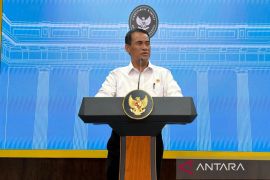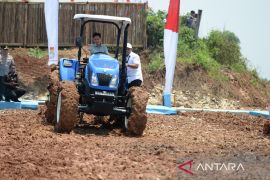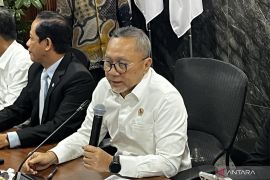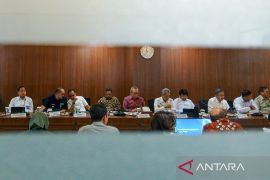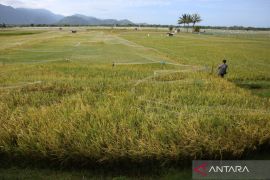Food self-sufficiency must be accelerated considering the increasingly worrying climate change scenario, the Israel-Palestine and Russia-Ukraine wars that have affected the global food supply chain, as well as the increase in the global population, which is estimated to reach 10 billion in the next few decades, requiring additional 56 percent food production.
These global conditions are posing the risk of triggering a global food crisis.
From a domestic perspective, there is an urgent need to accelerate food self-sufficiency to support the Free Nutritious Meal Program for students, toddlers, and pregnant women.
Initiated by President Prabowo Subianto, the program is targeting to cover more than 80 million beneficiaries by 2029.
In the long term, Indonesia will experience a demographic bonus in 2030, where the productive age population will dominate the population age structure.
This will require strengthening food security to meet the increase in food consumption.
Considering these conditions, the Prabowo-Gibran administration has been carrying out several measures to accelerate food self-sufficiency.
In terms of budget, the government has re-prioritized the budget, allocating Rp23.61 trillion for activities for building rice self-sufficiency and Rp413.67 billion for the free meals program.
The next step is the plan to cultivate 2.3 million hectares of rice fields, including optimizing new rice fields, as well as normalizing tertiary, primary, and secondary irrigation in existing areas.
The government is also continuing the food estate program, which is playing an important role in creating sustainable national food security while giving rise to food distribution hubs in regions.
Those policies need to be followed up by a number of supporting strategies, including infrastructure development, to successfully accelerate food self-sufficiency.
Irrigation
The first infrastructure strategy is irrigation development and rehabilitation. Irrigation infrastructure plays an important role in distributing water from dams and reservoirs to rice fields.
To implement this strategy, a number of policies have been prepared, including the development of 10 thousand hectares and the rehabilitation of 45 thousand hectares of irrigation networks.
Among the irrigation networks that are currently being constructed is Semantok Kiri in Nganjuk, East Java.
The irrigation network will seek to connect Semantok Dam with farmers' rice fields. The dam currently irrigates 1,906 hectares of agricultural land.
Semantok Dam has a capacity of 23 million cubic meters sourced from the Semantok River, with a catchment area of 365 hectares. The dam was inaugurated by former president Joko Widodo in December 2022 and began providing benefits after two years of planting seasons, even during the dry season.
However, to increase agricultural productivity and support the development of East Java as a national food barn, it is necessary to build the Semantok Kiri irrigation channel in 2025, for which, the government has allocated a budget of Rp67 billion.
The construction of the Semantok Kiri irrigation network is expected to add 499 hectares of irrigated agricultural area to support East Java as a food barn.
In addition to building new irrigation networks, the government is also trying to rehabilitate existing networks by modernizing irrigation.
The Siman Irrigation Area in Jombang, East Java, is an example of how modernization using technology and digitalization can help automate water gates to regulate the height and distribution of irrigation water.
The modernized and digitalized Siman-Serinjing irrigation service covers an area of 4,525 hectares in the Kediri and Jombang regencies. The modernization was carried out to increase the productivity and efficiency of irrigation areas so that water could be distributed evenly to agricultural lands.
The modernization of the Siman Irrigation Area has provided benefits by increasing the cropping index from 237 percent to 260 percent. In addition, the production of rice and secondary crops has increased from 50,500 tons to 62 thousand tons.
Connectivity for food centers
The next infrastructure development strategy is supporting road and bridge connectivity to food production centers as well as food estates.
The implementation of the Presidential Instruction on Regional Road is one of the priority infrastructure programs that must be continued.
The regulation will not only provide great benefits to the community, but also have a role in connecting the distribution network from many production centers and food estates to the nearest cities or distribution hubs.
The purpose of implementing the presidential instruction is to improve the stability of regional roads across Indonesia.
Therefore, the government plans to allocate a budget of Rp37.31 trillion for the construction of new roads and bridges as well as the maintenance of existing roads and bridges.
The connectivity support plan for the food estate is focused on the Merauke Food Estate Area in South Papua, the Keerom Food Estate Area in Papua, as well as the Belanti, Singkong, Dadahup Food Estate Area in Central Kalimantan.
The implementation of the Presidential Instruction on Regional Road to support food self-sufficiency is important for reducing logistics costs so that food can be made immediately available at prices that are affordable for the community.
Completion of dams
Completion of dams is another infrastructure development strategy to accelerate national food self-sufficiency.
This strategy is being implemented by inaugurating dams that have been completed, such as Keureuto in Aceh and Jlantah in Central Java, so that they can be directly operated as a source of water for rice fields.
The construction of new dams is also continuing considering that reservoirs are key for supporting food and water security.
The government built 187 dams until 2014. Sixty-one more dams were slated for completion from 2015 to 2025, as well as an additional 11 dam projects announced, taking the total number of dams to 259.
The construction of new dams aims to increase Indonesia's water security index to 200 cubic meters per capita per year, with even distribution throughout the regions.
This would allow the productivity of rice fields to increase, with planting frequency during the planting season increasing from two to three.
This increase in productivity could be possible once farmers' rice fields no longer rely on rainwater, but on irrigation networks from dams.
If the water security index increases, it could also contribute to increasing the planting index and increasing food reserves for the Free Nutritious Meals program while anticipating the demographic bonus in 2030.
Related news: Indonesia aware of importance of dams for food, energy security
Related news: Indonesia's BRIN highlights AI as key ally in bolstering food security
Editor: Rahmad Nasution
Copyright © ANTARA 2024


